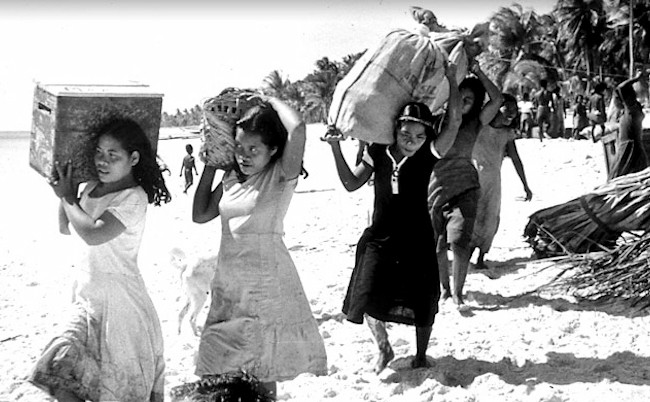
At 60, Bravo legacy still reverberates
March 1 is a national holiday in the Marshall Islands marking the day the Bravo hydrogen bomb was exploded at Bikini Atoll, spewing radioactive fallout on islands around the Marshall Islands. This year’s 60th anniversary is being marked in Majuro and other locations around the world. For most Marshall Islanders, it will be a time to reflect on the fact that the U.S nuclear weapons test legacy has left numerous unresolved issues for their nation.
One of the most important outstanding issues is the U.S Congress’ lack of official response to a petition for more compensation and health care funding submitted over 13 years ago to Washington by the Marshall Islands government. The point of the petition, which was submitted pursuant to provisions of the Compact of Free Association, is to get the U.S government to pay the awards adjudicated by the Nuclear Claims Tribunal, which was established by the Compact. Tribunal awards for personal injuries and only four of the most seriously affected atolls are over USD2 billion. These have not been paid because U.S funding provided under the 1983 agreement proved to be far short of the amount needed to satisfy awards made by the Tribunal during its period of operations from the early 1990s to the late 2000s. Demonstrating the inequity of the situation, American ‘Downwinders’ exposed to U.S nuclear testing at the Nevada Test Site are treated differently. When the U.S. Congress passed a nuclear compensation law for Downwinders (and others) in 1990, it appropriated $100 million. When that initial amount did not cover the ongoing number of awards issued by the U.S Justice Department, what did the U.S Congress do? It responded by appropriating additional compensation funds. The amount paid out to Downwinders and other Americans under this legislation has now risen to over USD 1.8 billion.
Further demonstrating the inequity of the situation is what we know about exposures of Americans to Nevada tests and doses received by Marshall Islanders from tests at Bikini and Enewetak. Of course, what we know from declassified U.S government reports does not reflect the true exposure, since monitoring in the 1950s captured only certain types of radiation and accounted only for external doses received. Still, what we know from these U.S documents is instructive. The lowest average exposure of Marshall Islanders—who are considered by the U.S government to be ‘unexposed’—is higher than the highest average exposure of Downwinders. It isn’t surprising that Marshallese were dosed with higher amounts given that the Bikini and Enewetak tests produced over 90 times the yield of the Nevada experiments. For obvious reasons, the U.S didn’t test its hydrogen bombs in the continental United States, just as France and Britain used the Pacific for their tests. But what is surprising is that the U.S government to this day, despite its own now declassified reports confirming the widespread extent of fallout contamination, still only recognises four atolls as exposed. In fact, many more than Bikini, Enewetak, Rongelap and Utrik were exposed to harmful radiation from some of the 67 tests.
A United Nations Special Rapporteur, in a report to the UN Human Rights Council in late 2012, urged the U.S government to pay the awards issued by the Tribunal. He made numerous other recommendations to address ongoing problems caused by the nuclear test legacy. It is an independent and dispassionate appraisal of the situation, which confirms that 60 years on, many issues remained unresolved. The Special Rapporteur found that: ‘The nuclear testing resulted in both immediate and continuing effects on the human rights of the Marshallese…The effects of radiation have been exacerbated by near-irreversible environmental contamination, leading to the loss of livelihoods and lands. Moreover, many people continue to experience indefinite displacement.’
The U.S. government, however, maintains that the Compact’s USD150 million compensation fund was ‘full and final’ and that no further compensation is needed or required—despite the fact that the U.S government withheld from Marshall Islands Compact negotiators secret reports that showed the widespread extent of fallout contamination that was not limited to the four atolls. The U.S continues to fund limited health care and medical programs for people affected by the testing, as well as conducting ongoing scientific research and monitoring. But much more must be done to address nuclear clean up, health care and environmental monitoring and study needs.
A series of events and workshops in Majuro for Nuclear Survivors Day on March 1 will feature exchanges among people with nuclear experiences from Japan, Australia, the Marshall Islands and elsewhere, as well as talking about shortcomings in the compensation and cleanup programs.
Whether these events push action on outstanding nuclear clean up, compensation and health care needs, they will connect people to issues that 60 years after American’s largest hydrogen bomb detonation are still a concern of significance in the Marshall Islands.
The Marshall Islands government needs to step up its engagement on the issue, because 13 years after its compensation petition was submitted to the U.S Congress, it is clear the government has little interest in addressing these issues. What is needed to advance Marshall Islands interests on this important issue is for the government to establish by law a nuclear agency with the mandate to pursue independent radiation environmental and health studies, gather information and resources, and pursue nuclear compensation, clean up and health funding and programs. Such an office would give these problems the focus they deserve, lending official sanction to efforts to resolve the legacy of American nuclear testing in the Marshall Islands.

